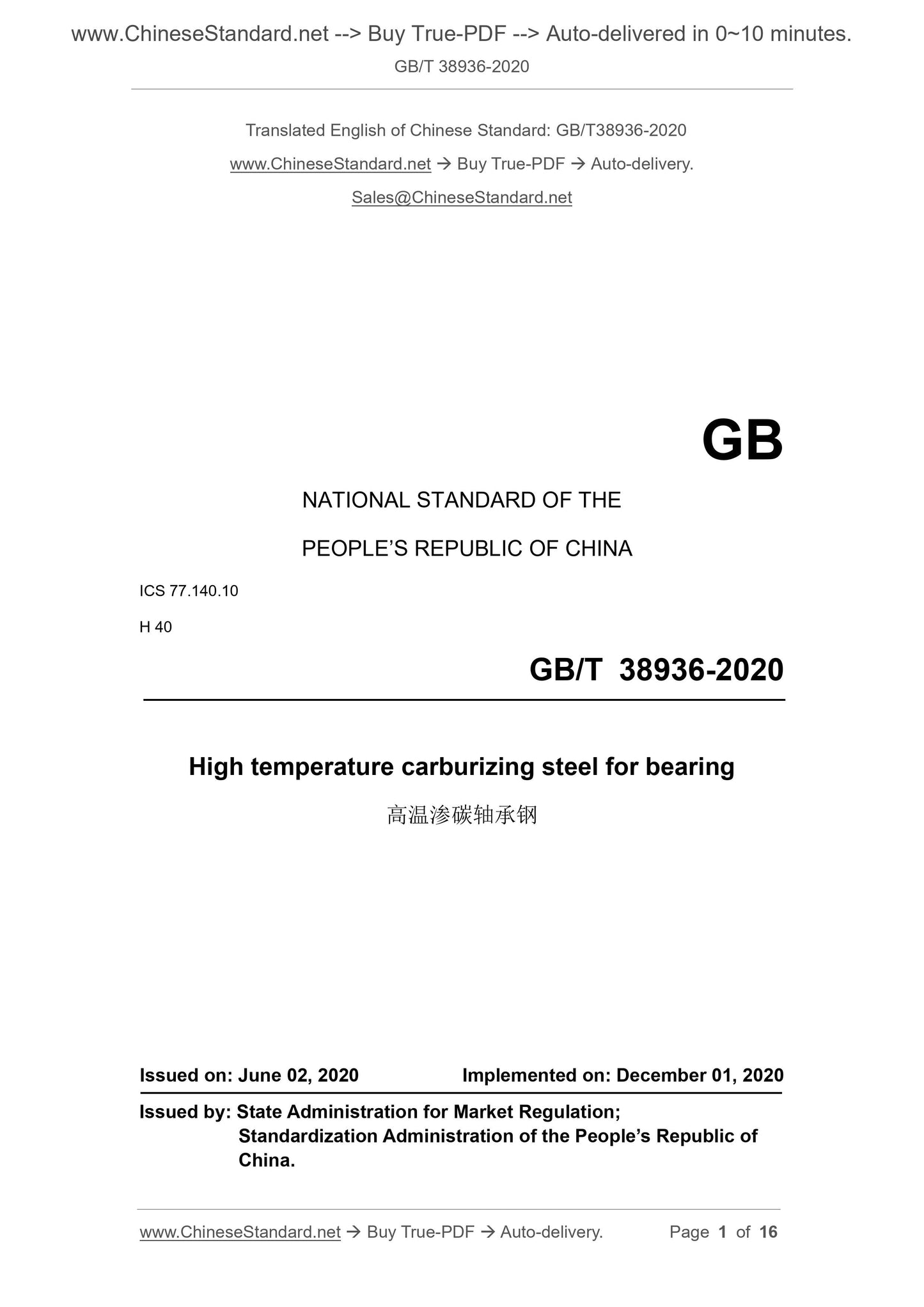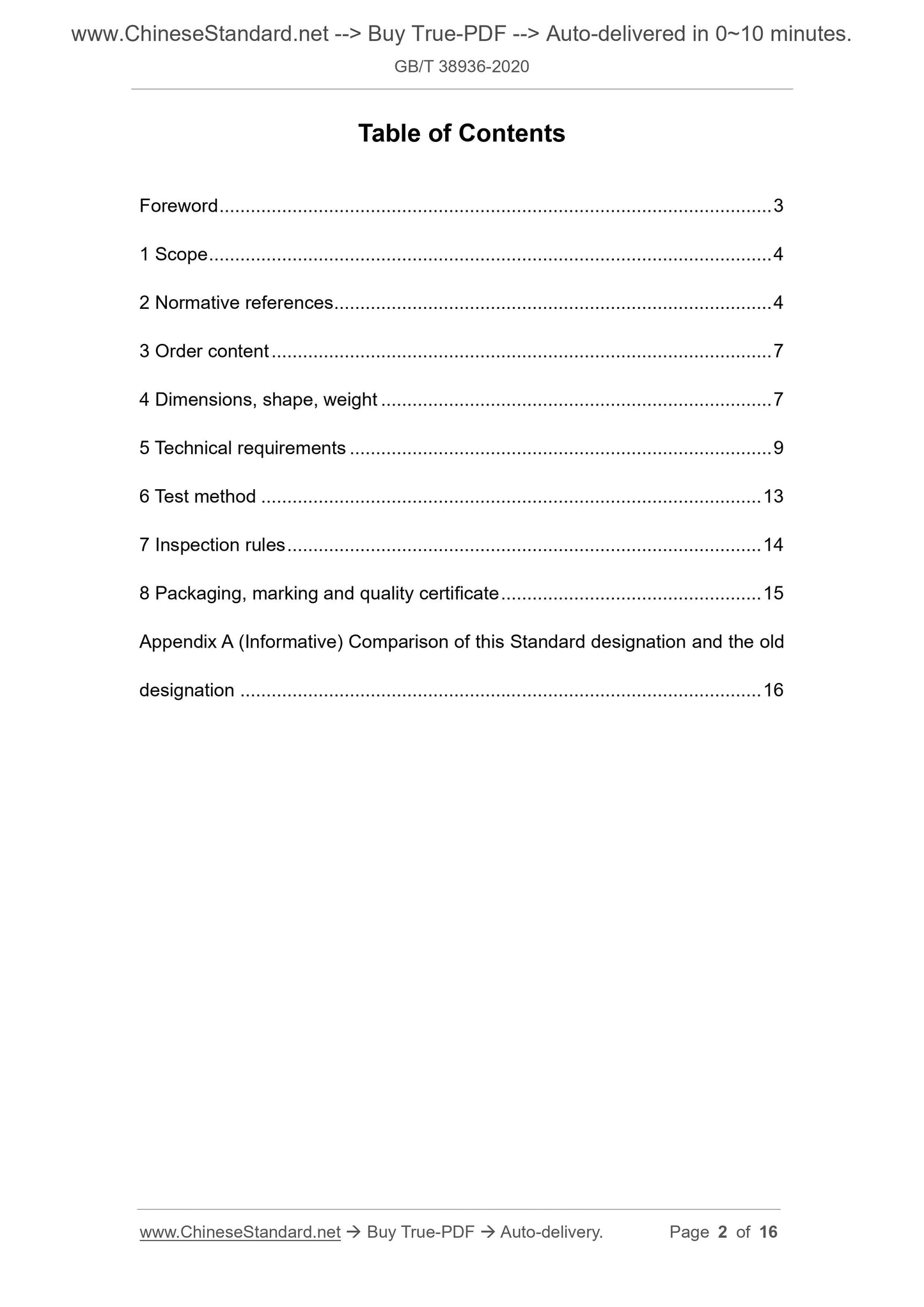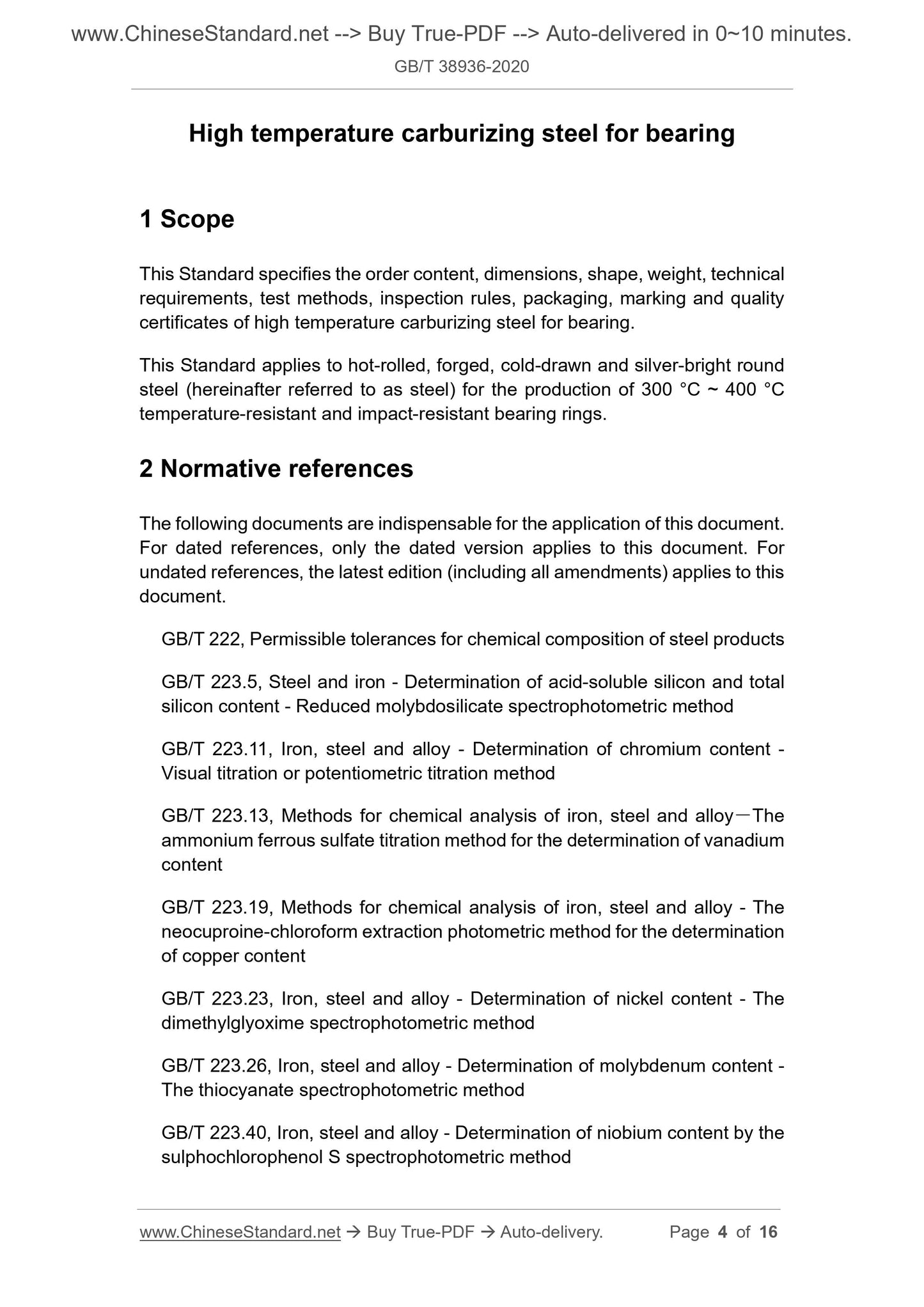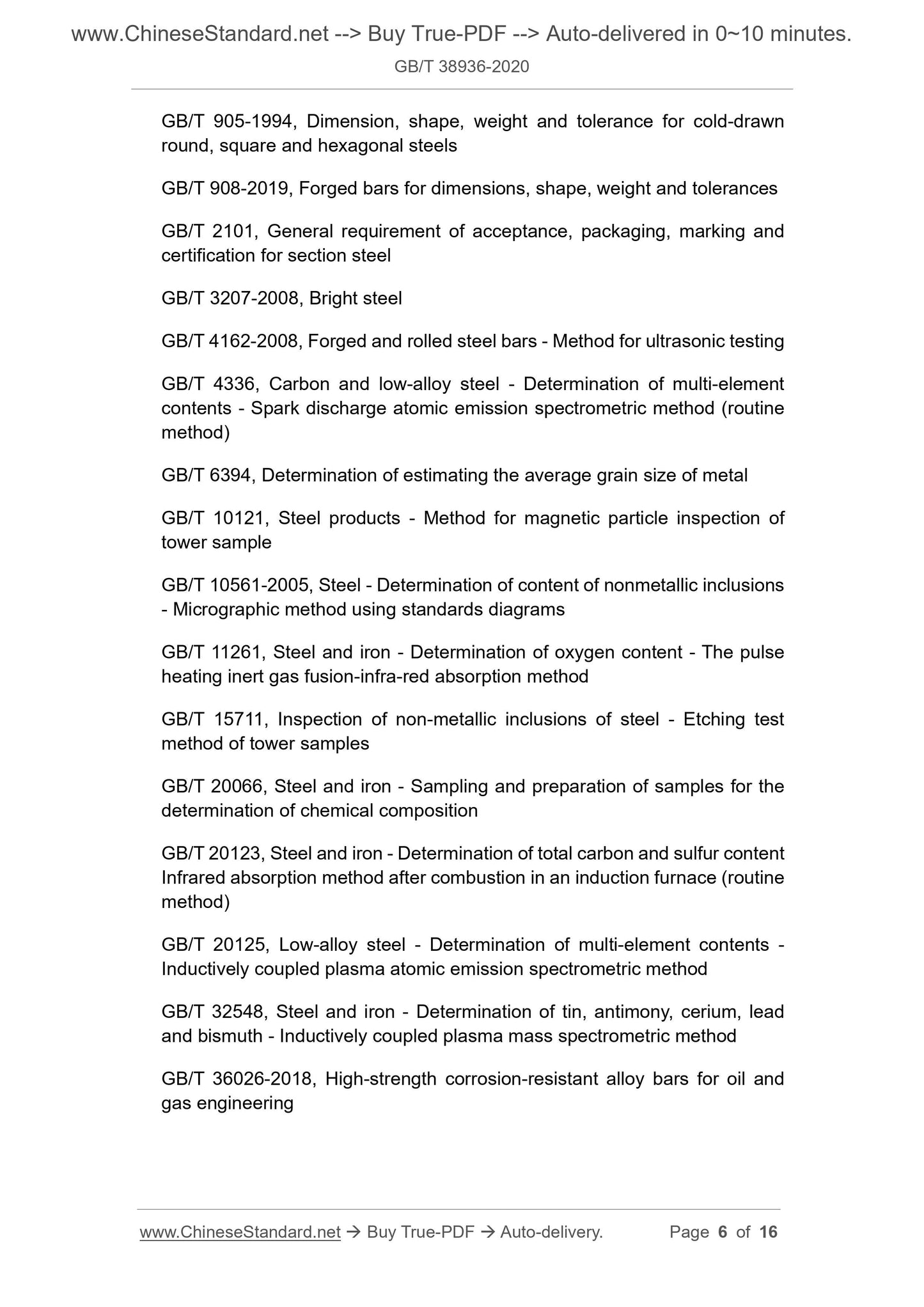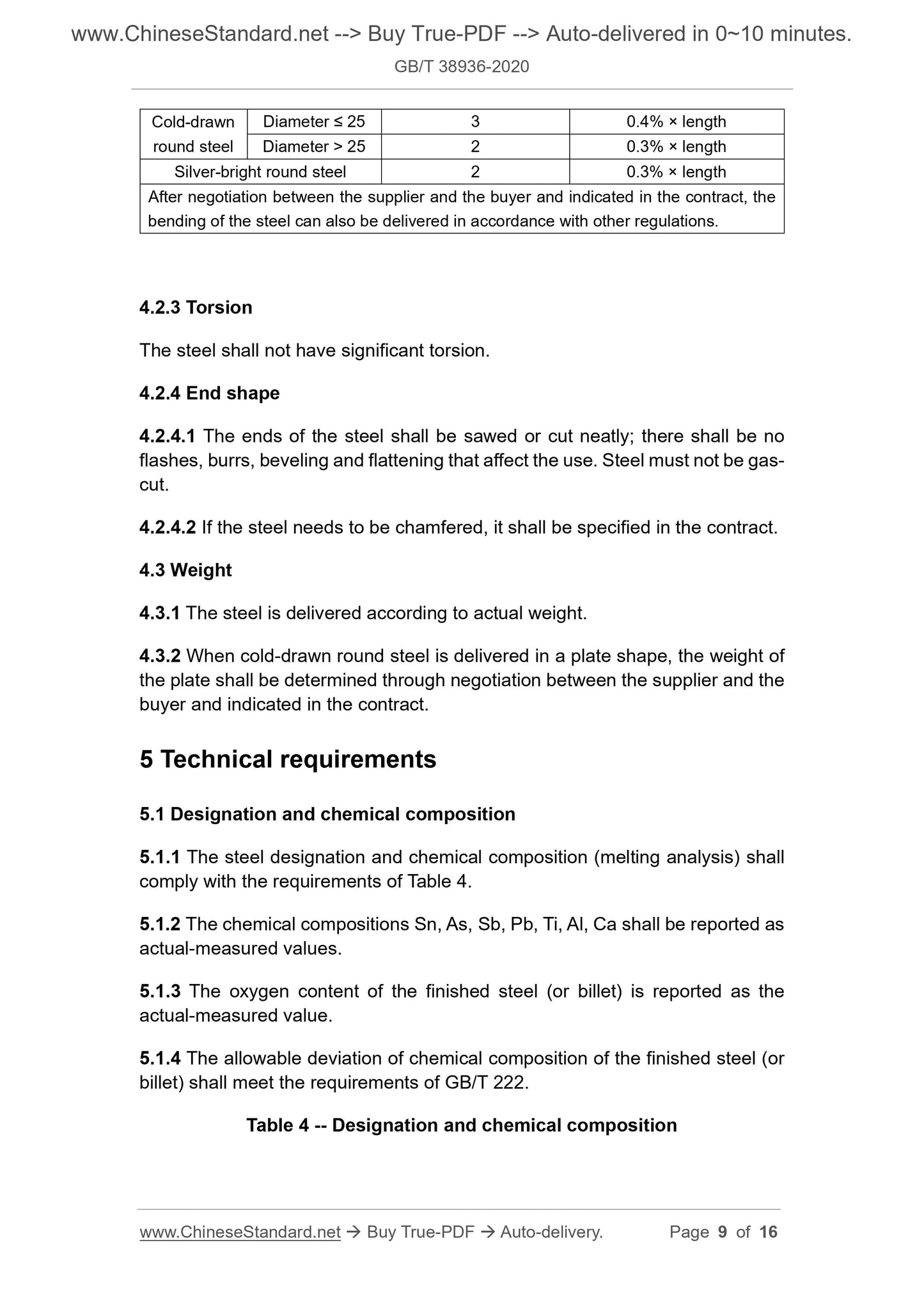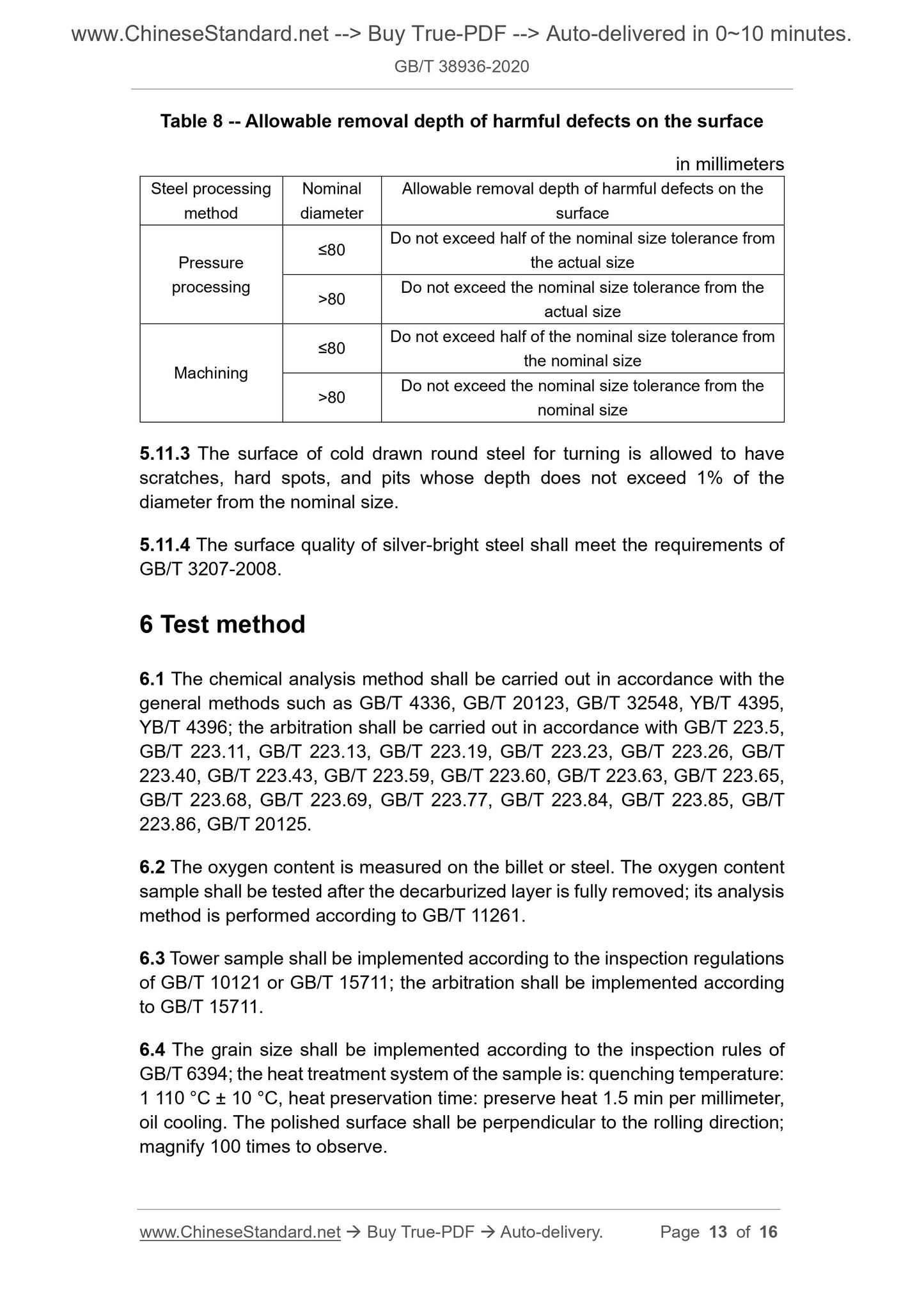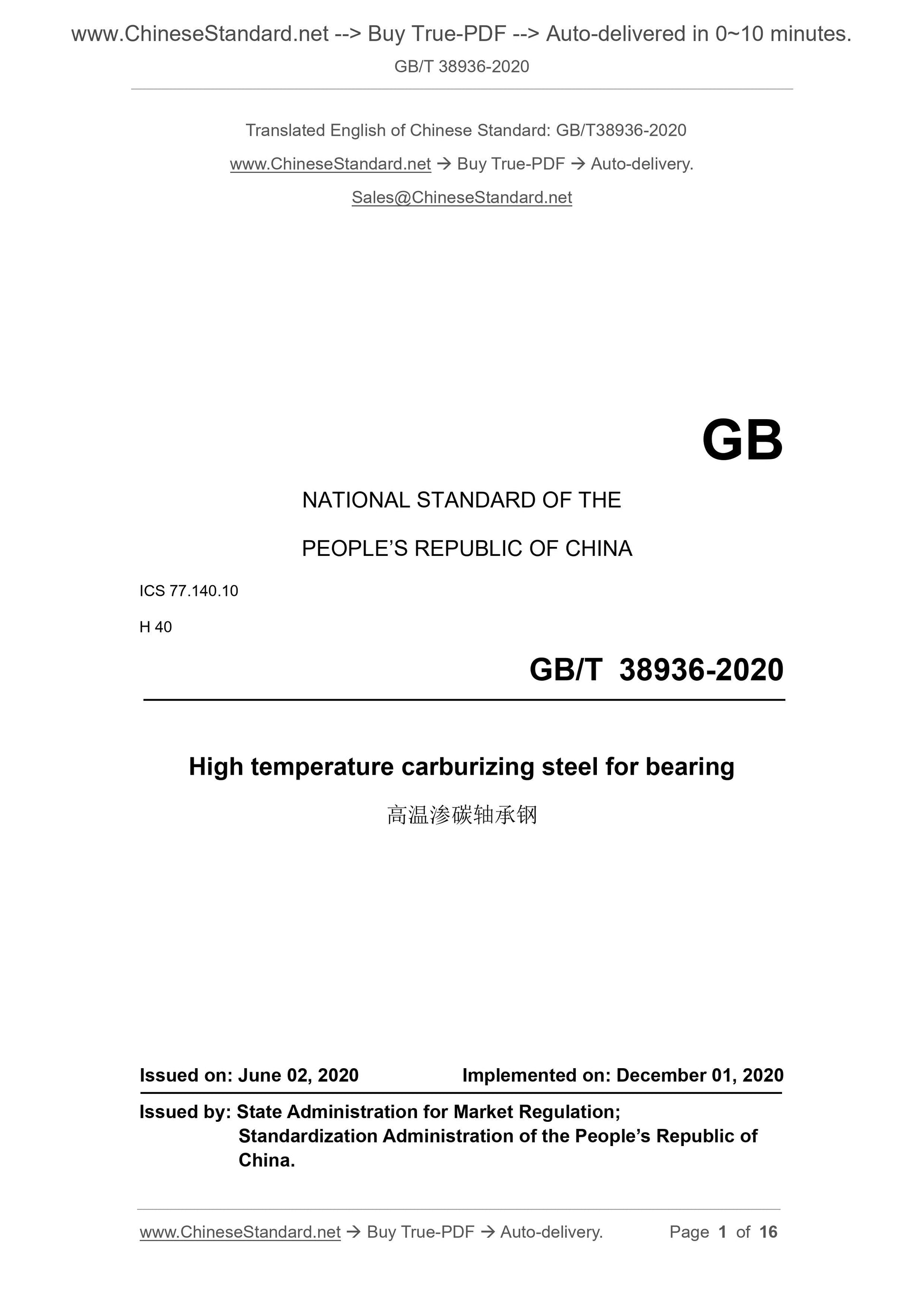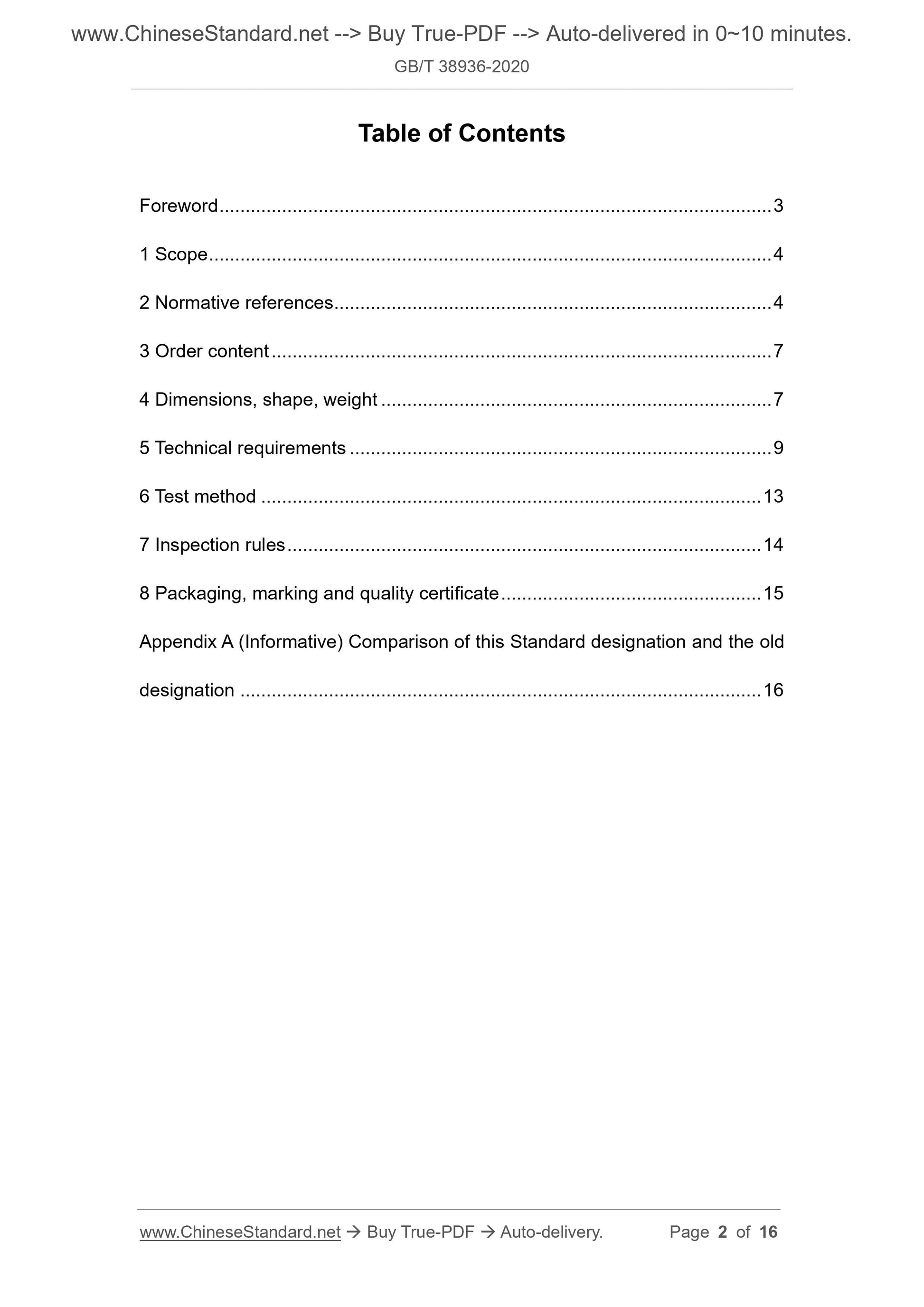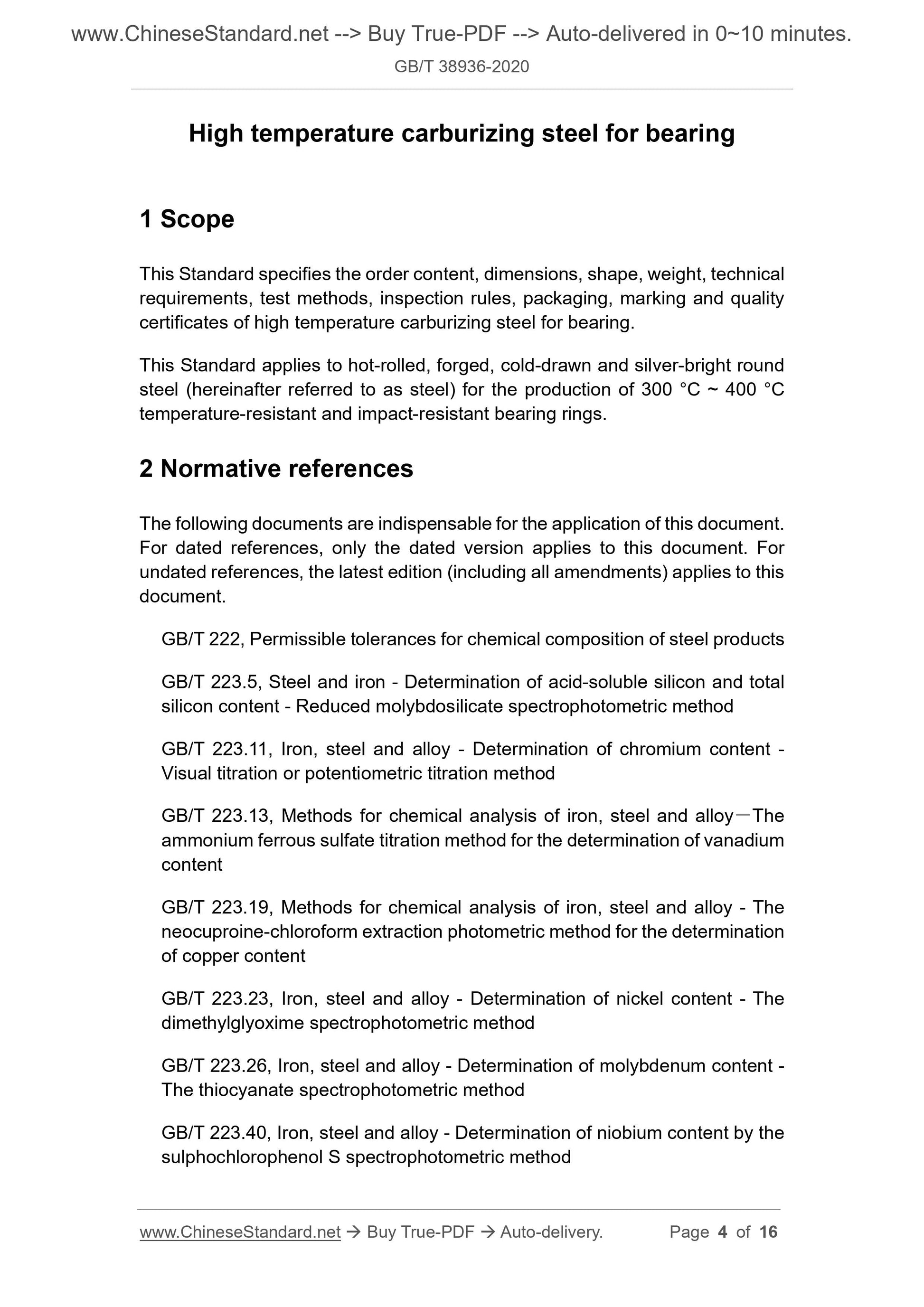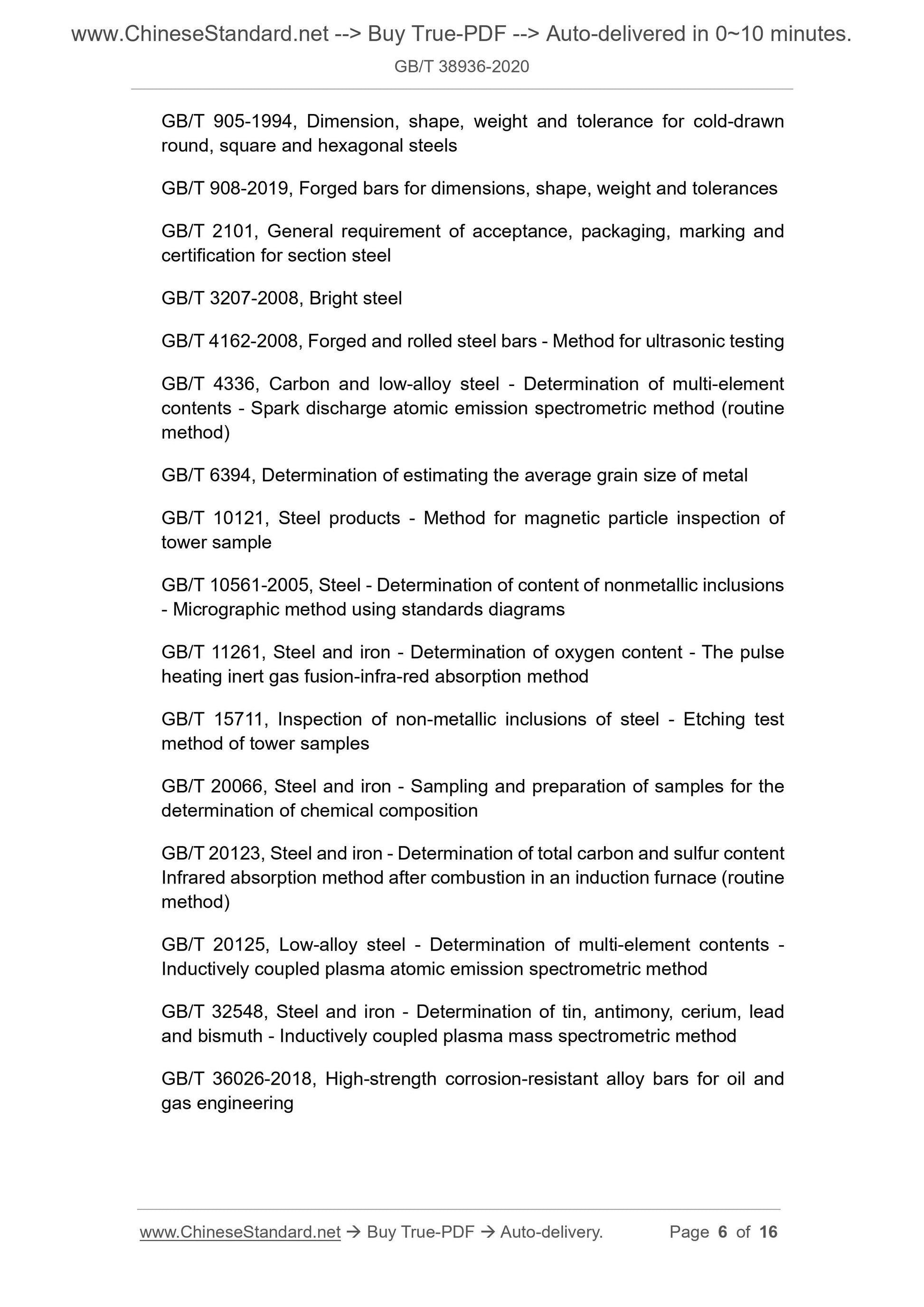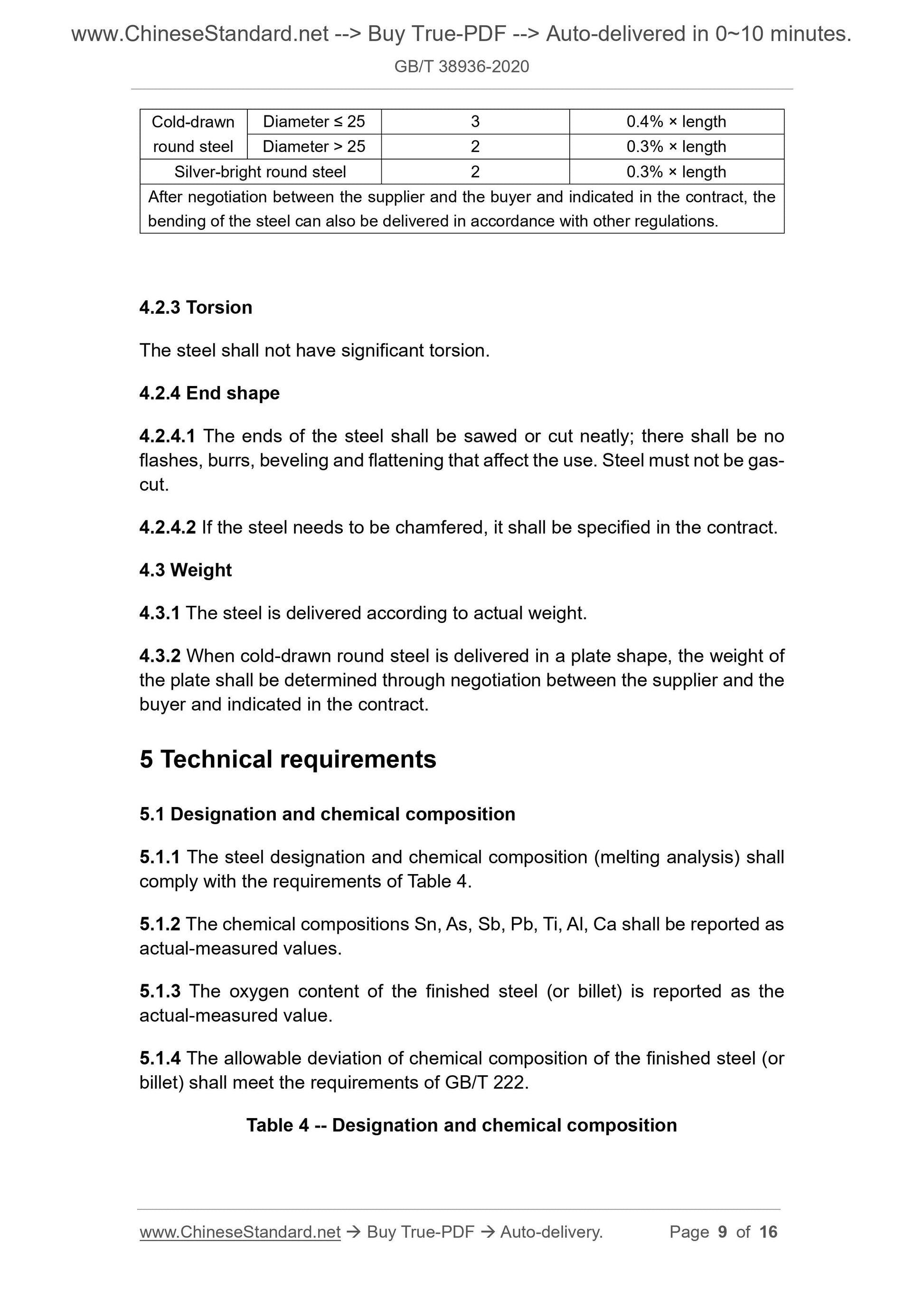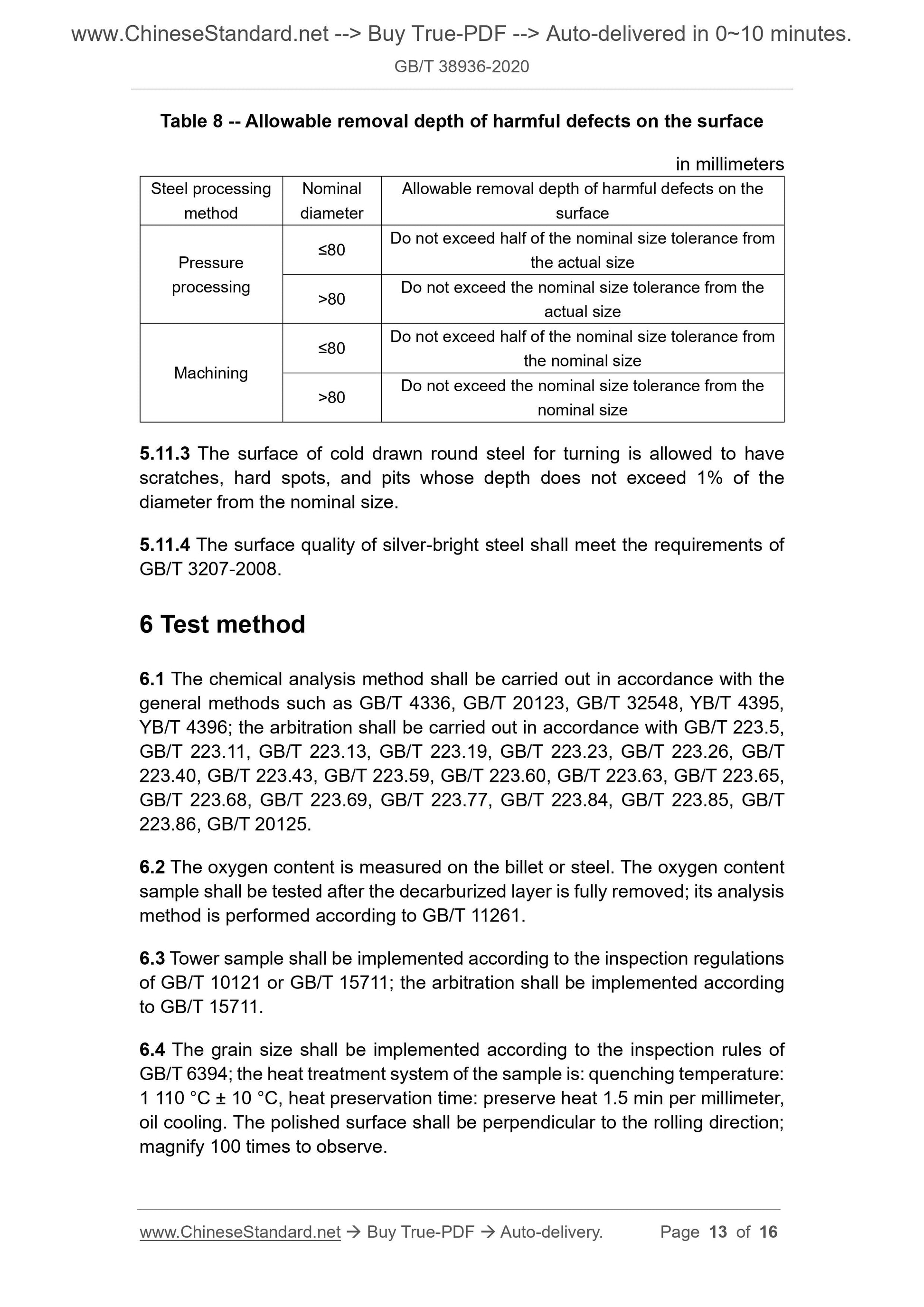1
/
de
6
PayPal, credit cards. Download editable-PDF & invoice in 1 second!
GB/T 38936-2020 English PDF (GBT38936-2020)
GB/T 38936-2020 English PDF (GBT38936-2020)
Prix habituel
$145.00 USD
Prix habituel
Prix promotionnel
$145.00 USD
Prix unitaire
/
par
Frais d'expédition calculés à l'étape de paiement.
Impossible de charger la disponibilité du service de retrait
Delivery: 3 seconds. Download true-PDF + Invoice.
Get QUOTATION in 1-minute: Click GB/T 38936-2020
Historical versions: GB/T 38936-2020
Preview True-PDF (Reload/Scroll if blank)
GB/T 38936-2020: High temperature carburizing steel for bearing
GB/T 38936-2020
GB
NATIONAL STANDARD OF THE
PEOPLE’S REPUBLIC OF CHINA
ICS 77.140.10
H 40
High temperature carburizing steel for bearing
ISSUED ON: JUNE 02, 2020
IMPLEMENTED ON: DECEMBER 01, 2020
Issued by: State Administration for Market Regulation;
Standardization Administration of the People’s Republic of
China.
Table of Contents
Foreword ... 3
1 Scope ... 4
2 Normative references ... 4
3 Order content ... 7
4 Dimensions, shape, weight ... 7
5 Technical requirements ... 9
6 Test method ... 13
7 Inspection rules ... 14
8 Packaging, marking and quality certificate ... 15
Appendix A (Informative) Comparison of this Standard designation and the old
designation ... 16
High temperature carburizing steel for bearing
1 Scope
This Standard specifies the order content, dimensions, shape, weight, technical
requirements, test methods, inspection rules, packaging, marking and quality
certificates of high temperature carburizing steel for bearing.
This Standard applies to hot-rolled, forged, cold-drawn and silver-bright round
steel (hereinafter referred to as steel) for the production of 300 °C ~ 400 °C
temperature-resistant and impact-resistant bearing rings.
2 Normative references
The following documents are indispensable for the application of this document.
For dated references, only the dated version applies to this document. For
undated references, the latest edition (including all amendments) applies to this
document.
GB/T 222, Permissible tolerances for chemical composition of steel products
GB/T 223.5, Steel and iron - Determination of acid-soluble silicon and total
silicon content - Reduced molybdosilicate spectrophotometric method
GB/T 223.11, Iron, steel and alloy - Determination of chromium content -
Visual titration or potentiometric titration method
GB/T 223.13, Methods for chemical analysis of iron, steel and alloy-The
ammonium ferrous sulfate titration method for the determination of vanadium
content
GB/T 223.19, Methods for chemical analysis of iron, steel and alloy - The
neocuproine-chloroform extraction photometric method for the determination
of copper content
GB/T 223.23, Iron, steel and alloy - Determination of nickel content - The
dimethylglyoxime spectrophotometric method
GB/T 223.26, Iron, steel and alloy - Determination of molybdenum content -
The thiocyanate spectrophotometric method
GB/T 223.40, Iron, steel and alloy - Determination of niobium content by the
sulphochlorophenol S spectrophotometric method
GB/T 905-1994, Dimension, shape, weight and tolerance for cold-drawn
round, square and hexagonal steels
GB/T 908-2019, Forged bars for dimensions, shape, weight and tolerances
GB/T 2101, General requirement of acceptance, packaging, marking and
certification for section steel
GB/T 3207-2008, Bright steel
GB/T 4162-2008, Forged and rolled steel bars - Method for ultrasonic testing
GB/T 4336, Carbon and low-alloy steel - Determination of multi-element
contents - Spark discharge atomic emission spectrometric method (routine
method)
GB/T 6394, Determination of estimating the average grain size of metal
GB/T 10121, Steel products - Method for magnetic particle inspection of
tower sample
GB/T 10561-2005, Steel - Determination of content of nonmetallic inclusions
- Micrographic method using standards diagrams
GB/T 11261, Steel and iron - Determination of oxygen content - The pulse
heating inert gas fusion-infra-red absorption method
GB/T 15711, Inspection of non-metallic inclusions of steel - Etching test
method of tower samples
GB/T 20066, Steel and iron - Sampling and preparation of samples for the
determination of chemical composition
GB/T 20123, Steel and iron - Determination of total carbon and sulfur content
Infrared absorption method after combustion in an induction furnace (routine
method)
GB/T 20125, Low-alloy steel - Determination of multi-element contents -
Inductively coupled plasma atomic emission spectrometric method
GB/T 32548, Steel and iron - Determination of tin, antimony, cerium, lead
and bismuth - Inductively coupled plasma mass spectrometric method
GB/T 36026-2018, High-strength corrosion-resistant alloy bars for oil and
gas engineering
Cold-drawn
round steel
Diameter ≤ 25 3 0.4% × length
Diameter > 25 2 0.3% × length
Silver-bright round steel 2 0.3% × length
After negotiation between the supplier and the buyer and indicated in the contract, the
bending of the steel can also be delivered in accordance with other regulations.
4.2.3 Torsion
The steel shall not have significant torsion.
4.2.4 End shape
4.2.4.1 The ends of the steel shall be sawed or cut neatly; there shall be no
flashes, burrs, beveling and flattening that affect the use. Steel must not be gas-
cut.
4.2.4.2 If the steel needs to be chamfered, it shall be specified in the contract.
4.3 Weight
4.3.1 The steel is delivered according to actual weight.
4.3.2 When cold-drawn round steel is delivered in a plate shape, the weight of
the plate shall be determined through negotiation between the supplier and the
buyer and indicated in the contract.
5 Technical requirements
5.1 Designation and chemical composition
5.1.1 The steel designation and chemical composition (melting analysis) shall
comply with the requirements of Table 4.
5.1.2 The chemical compositions Sn, As, Sb, Pb, Ti, Al, Ca shall be reported as
actual-measured values.
5.1.3 The oxygen content of the finished steel (or billet) is reported as the
actual-measured value.
5.1.4 The allowable deviation of chemical composition of the finished steel (or
billet) shall meet the requirements of GB/T 222.
Table 4 -- Designation and chemical composition
Table 8 -- Allowable removal depth of harmful defects on the surface
in millimeters
Steel processing
method
Nominal
diameter
Allowable removal depth of harmful defects on the
surface
Pressure
processing
≤80 Do not exceed half of the nominal size tolerance from the actual size
>80 Do not exceed the nominal size tolerance from the actual size
Machining
≤80 Do not exceed half of the nominal size tolerance from the nominal size
>80 Do not exceed the nominal size tolerance from the nominal size
5.11.3 The surface of cold drawn round steel for turning is allowed to have
scratches, hard spots, and pits whose depth does not exceed 1% of the
diameter from the nominal size.
5.11.4 The surface quality of silver-bright steel shall meet the requirements of
GB/T 3207-2008.
6 Test method
6.1 The chemical analysis method shall be carried out in accordance with the
general methods such as GB/T 4336, GB/T 20123, GB/T 32548, YB/T 4395,
YB/T 4396; the arbitration shall be carried out in accordance with GB/T 223.5,
GB/T 223.11, GB/T 223.13, GB/T 223.19, GB/T 223.23, GB/T 223.26, GB/T
223.40, GB/T 223.43, GB/T 223.59, GB/T 223.60, GB/T 223.63, GB/T 223.65,
GB/T 223.68, GB/T 223.69, GB/T 223.77, GB/T 223.84, GB/T 223.85, GB/T
223.86, GB/T 20125.
6.2 The oxygen content is measured on the billet or steel. The oxygen content
sample shall be tested after the decarburized layer is fully removed; its analysis
method is performed according to GB/T 11261.
6.3 Tower sample shall be implemented according to the inspection regulations
of GB/T 10121 or GB/T 15711; the arbitration shall be implemented according
to GB/T 15711.
6.4 The grain size shall be implement...
Get QUOTATION in 1-minute: Click GB/T 38936-2020
Historical versions: GB/T 38936-2020
Preview True-PDF (Reload/Scroll if blank)
GB/T 38936-2020: High temperature carburizing steel for bearing
GB/T 38936-2020
GB
NATIONAL STANDARD OF THE
PEOPLE’S REPUBLIC OF CHINA
ICS 77.140.10
H 40
High temperature carburizing steel for bearing
ISSUED ON: JUNE 02, 2020
IMPLEMENTED ON: DECEMBER 01, 2020
Issued by: State Administration for Market Regulation;
Standardization Administration of the People’s Republic of
China.
Table of Contents
Foreword ... 3
1 Scope ... 4
2 Normative references ... 4
3 Order content ... 7
4 Dimensions, shape, weight ... 7
5 Technical requirements ... 9
6 Test method ... 13
7 Inspection rules ... 14
8 Packaging, marking and quality certificate ... 15
Appendix A (Informative) Comparison of this Standard designation and the old
designation ... 16
High temperature carburizing steel for bearing
1 Scope
This Standard specifies the order content, dimensions, shape, weight, technical
requirements, test methods, inspection rules, packaging, marking and quality
certificates of high temperature carburizing steel for bearing.
This Standard applies to hot-rolled, forged, cold-drawn and silver-bright round
steel (hereinafter referred to as steel) for the production of 300 °C ~ 400 °C
temperature-resistant and impact-resistant bearing rings.
2 Normative references
The following documents are indispensable for the application of this document.
For dated references, only the dated version applies to this document. For
undated references, the latest edition (including all amendments) applies to this
document.
GB/T 222, Permissible tolerances for chemical composition of steel products
GB/T 223.5, Steel and iron - Determination of acid-soluble silicon and total
silicon content - Reduced molybdosilicate spectrophotometric method
GB/T 223.11, Iron, steel and alloy - Determination of chromium content -
Visual titration or potentiometric titration method
GB/T 223.13, Methods for chemical analysis of iron, steel and alloy-The
ammonium ferrous sulfate titration method for the determination of vanadium
content
GB/T 223.19, Methods for chemical analysis of iron, steel and alloy - The
neocuproine-chloroform extraction photometric method for the determination
of copper content
GB/T 223.23, Iron, steel and alloy - Determination of nickel content - The
dimethylglyoxime spectrophotometric method
GB/T 223.26, Iron, steel and alloy - Determination of molybdenum content -
The thiocyanate spectrophotometric method
GB/T 223.40, Iron, steel and alloy - Determination of niobium content by the
sulphochlorophenol S spectrophotometric method
GB/T 905-1994, Dimension, shape, weight and tolerance for cold-drawn
round, square and hexagonal steels
GB/T 908-2019, Forged bars for dimensions, shape, weight and tolerances
GB/T 2101, General requirement of acceptance, packaging, marking and
certification for section steel
GB/T 3207-2008, Bright steel
GB/T 4162-2008, Forged and rolled steel bars - Method for ultrasonic testing
GB/T 4336, Carbon and low-alloy steel - Determination of multi-element
contents - Spark discharge atomic emission spectrometric method (routine
method)
GB/T 6394, Determination of estimating the average grain size of metal
GB/T 10121, Steel products - Method for magnetic particle inspection of
tower sample
GB/T 10561-2005, Steel - Determination of content of nonmetallic inclusions
- Micrographic method using standards diagrams
GB/T 11261, Steel and iron - Determination of oxygen content - The pulse
heating inert gas fusion-infra-red absorption method
GB/T 15711, Inspection of non-metallic inclusions of steel - Etching test
method of tower samples
GB/T 20066, Steel and iron - Sampling and preparation of samples for the
determination of chemical composition
GB/T 20123, Steel and iron - Determination of total carbon and sulfur content
Infrared absorption method after combustion in an induction furnace (routine
method)
GB/T 20125, Low-alloy steel - Determination of multi-element contents -
Inductively coupled plasma atomic emission spectrometric method
GB/T 32548, Steel and iron - Determination of tin, antimony, cerium, lead
and bismuth - Inductively coupled plasma mass spectrometric method
GB/T 36026-2018, High-strength corrosion-resistant alloy bars for oil and
gas engineering
Cold-drawn
round steel
Diameter ≤ 25 3 0.4% × length
Diameter > 25 2 0.3% × length
Silver-bright round steel 2 0.3% × length
After negotiation between the supplier and the buyer and indicated in the contract, the
bending of the steel can also be delivered in accordance with other regulations.
4.2.3 Torsion
The steel shall not have significant torsion.
4.2.4 End shape
4.2.4.1 The ends of the steel shall be sawed or cut neatly; there shall be no
flashes, burrs, beveling and flattening that affect the use. Steel must not be gas-
cut.
4.2.4.2 If the steel needs to be chamfered, it shall be specified in the contract.
4.3 Weight
4.3.1 The steel is delivered according to actual weight.
4.3.2 When cold-drawn round steel is delivered in a plate shape, the weight of
the plate shall be determined through negotiation between the supplier and the
buyer and indicated in the contract.
5 Technical requirements
5.1 Designation and chemical composition
5.1.1 The steel designation and chemical composition (melting analysis) shall
comply with the requirements of Table 4.
5.1.2 The chemical compositions Sn, As, Sb, Pb, Ti, Al, Ca shall be reported as
actual-measured values.
5.1.3 The oxygen content of the finished steel (or billet) is reported as the
actual-measured value.
5.1.4 The allowable deviation of chemical composition of the finished steel (or
billet) shall meet the requirements of GB/T 222.
Table 4 -- Designation and chemical composition
Table 8 -- Allowable removal depth of harmful defects on the surface
in millimeters
Steel processing
method
Nominal
diameter
Allowable removal depth of harmful defects on the
surface
Pressure
processing
≤80 Do not exceed half of the nominal size tolerance from the actual size
>80 Do not exceed the nominal size tolerance from the actual size
Machining
≤80 Do not exceed half of the nominal size tolerance from the nominal size
>80 Do not exceed the nominal size tolerance from the nominal size
5.11.3 The surface of cold drawn round steel for turning is allowed to have
scratches, hard spots, and pits whose depth does not exceed 1% of the
diameter from the nominal size.
5.11.4 The surface quality of silver-bright steel shall meet the requirements of
GB/T 3207-2008.
6 Test method
6.1 The chemical analysis method shall be carried out in accordance with the
general methods such as GB/T 4336, GB/T 20123, GB/T 32548, YB/T 4395,
YB/T 4396; the arbitration shall be carried out in accordance with GB/T 223.5,
GB/T 223.11, GB/T 223.13, GB/T 223.19, GB/T 223.23, GB/T 223.26, GB/T
223.40, GB/T 223.43, GB/T 223.59, GB/T 223.60, GB/T 223.63, GB/T 223.65,
GB/T 223.68, GB/T 223.69, GB/T 223.77, GB/T 223.84, GB/T 223.85, GB/T
223.86, GB/T 20125.
6.2 The oxygen content is measured on the billet or steel. The oxygen content
sample shall be tested after the decarburized layer is fully removed; its analysis
method is performed according to GB/T 11261.
6.3 Tower sample shall be implemented according to the inspection regulations
of GB/T 10121 or GB/T 15711; the arbitration shall be implemented according
to GB/T 15711.
6.4 The grain size shall be implement...
Share
